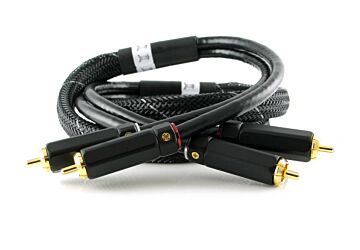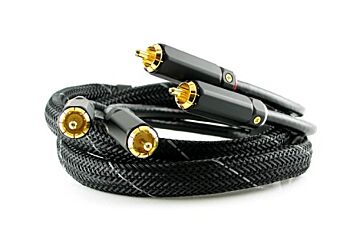We use cookies to make your experience better. We would like to set cookies on your browser. Learn more.
Graham Slee Lautus Analogue Interconnect
Free UK Delivery
Graham Slee Lautus Analogue Interconnect
The Lautus interconnect from Graham Slee is a highly capable interconnect. To reduce interference within the cable, the Lautus has been fitted with a number of sophisticated filter systems at specific points within the cable, worked out from the velocity factor of the cable - this filters the most powerful and common frequencies of interference. These filters are called Ferrites and the strategic placement of them within the cable reduces the effects of RF interference, allowing the cable to deliver a much better performance and a more stable connection. Better For Bass?Yes! In our opinion Lautus interconnect cables will make a difference to your bass (keep reading—all will be revealed!).It's not only a wonderful sounding stereo audio cable - it will also keep interference at bay* and will give you a really well-balanced sound quality. And compared with some interconnects the Lautus is terrific value for money.Available in stereo "dual-mono" pairs as an RCA to RCA interconnect from 1.5m to 3m in length – a single cable is also offered which is suitable for 75Ω coaxial S/PDIF use. There is also a 1.2m long USB-Audio version, and a "Power-Wire" suitable for the Bitzie USB DAC (click through for details).
So how do they do it?
We must point out that the idea behind the Lautus is pure hypothesis and is yet to be scientifically tested.
EMC legislation highlights the fact that we live in a world of ever-increasing interference.The interference with our precious audio signals comes from the proliferation of wireless devices.It also comes from "green-energy" power-supplies which emit and therefore must transmit at least some of their ultra-high frequency distortion. And because legislation demands it, "green energy" devices are everywhere.Interference can "land" on cables and pass into your equipment where it can mix with the high frequency harmonic distortion all amplifiers and preamps will have to some extent.
Because of radio we understand that a modulated frequency, when mixed with another frequency, can produce a sound at a frequency we can hear.For example: an amplifier which isn't effectively immune will sometimes accidentally "tune" to a radio station which you'll hear in the background. Most people will have come across this at some time.This demonstrates the need for cables to have effective shielding to prevent this happening and the Lautus has that effective shielding (or screening as it is known in some circles).But the Lautus has more. It uses ferrite filters placed at positions along the cable which were found to give the best subjective results.And those results were that the bass felt deeper - became clearer - more well defined. Not louder - just more complete.
So what's the theory?
As we said above, all amplifiers and preamps will have some high frequency harmonic distortion, and in addition to that there will always be some instability no matter how well an amp or preamp is designed to avoid it, because no electronic component is perfect - they all have what are known as parasitics.
The frequencies output from one type of preamp or another, or a DAC, or any piece of electronics that outputs an analogue signal, or even a digital signal such as S/PDIF or USB, will not be absolutely pure.
All signals have added distortion artefacts and together these are sent in cables. It is current flow and all currents flow in circles. In coaxial cables they go by the signal conductor and return by the shield (or should do if proper cable design practice is followed).
The source is the return (Kirchhoff's current law) so the signal in the cable has its origin or node just behind the socket of the source equipment. We know that effective shielding prevents outside interference mixing with our signals but the source is also "sending" interference on top of its signal inside the cable.
We'll call it high frequency distortion or harmonics, and when that mixes with the harmonics produced by the receiving equipment (such as an amplifier), by the same "radio effect" as discussed above, false audible frequencies "fall-out" - new noises emerge which aren't any part of the original sound.
These new noises tend to be at high audible frequencies and often go unnoticed, but upset the top to bottom sound balance and more often than not, the bass suffers - it appears "thin" or overly "tight".
The ferrite filters on the Lautus are placed at two measured positions away from the signal origin where theory says the first anti-nodes of wavelengths for frequencies at 100MHz and 200MHz happen, based on the propagation velocity of the cable type being used (the Lautus S/PDIF and USB has only one ferrite).
These anti-nodes will not be the exact anti-nodes for all high frequency harmonics generated in the source equipment, but are the common frequencies of analogue and digital broadcasts, which can easily "travel through" source electronics.
Lower high frequency harmonic waveforms will be rising toward their anti-nodes at the ferrite positions so will have an effect on these too.
The theory says that the ½ turn transformers formed by the ferrites short the send and return frequencies to which the anti-nodes are "tuned" and a short circuit prevents current flow. These positions also become the new origins of the source at those frequencies due to the "shorts" - after which the signal should be much clearer.
| Coax stock cable diameter | 6.5mm |
| Sheathed diameter | 10mm |
| Inner conductor | 1mm diameter solid s oft annealed copper; DC resistance: 0.026 Ohms per metre |
| Shield | Annealed copper braid over 100% copper foil wrap; DC resistance: 0.015 Ohms per metre |
| Jacket | PVC |
| Dielectric | 5 cell semi air-spaced |
| Dielectric constant | 1.49 |
| Velocity ratio | 0.82 (82%) |
| Capacitance | 55pf per metre |
| Characteristic impedance | 75 Ohms |
| Shielding efficiency | Better than 65dB |
| Lay-up stereo pair | Separated stereo pair overall flexible PVC braided with welded ends |
| Direction | Marked as "run of the mill" |
| Min safe bend diameter | 150mm (6 in) |
| Phono terminations | Locking phono (RCA) plugs with gold plated contacts |
UK Delivery
Providing your item is in stock, the order is usually dispatched within 24 hours. Postage and packing is completely free for orders over £99*. Out of stock items will be dispatched as soon as they become available, which can take between 4 to 21 days
UK Delivery orders are sent via our couriers' DPD Local on a next-day-delivery service and usually take between 1 and 3 days.
Local Delivery
Certain manufacturers disallow mail order for their products, however a local delivery may be possible.
We offer a local delivery service for a large number of our products. After your order has been placed, a member of the Hifi Gear team will contact you to arrange a convenient date and time for your local, personal delivery.
Click & Collect
We offer a free ‘Click & Collect’ service on all items. As soon as your order has been completed and is ready for collection a member of our team will be in contact with you. Orders can be collected from our store at 11 King Street, Hereford, HR4 9BW.
Please use this link to find more detailed delivery information or contact us for more details




